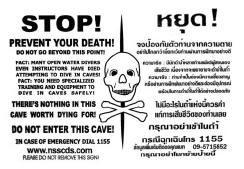Cave Diving Safety
Cave diving- just how safe?
Accident analysis revisited (“just one more time folks!”) by Matt London
Cave diving was once considered the world’s most dangerous sport. Today cave diving has evolved into a relatively safe sport – providing you follow strict adherence to well established rules and protocols.
In 1977 Sheck Exley (then America’s paramount cave diver) conducted an NSS (National Speleological Society) sponsored study of all the cave diving accidents for which data was available up until that time. After first compiling a list of the rules and procedures considered essential in safe cave diving. Exley then began checking off those rules and procedures violated in each of the cave diving fatalities. Interestingly in all but one of the cave diving fatalities the same three fundamental safety violations occurred repeatedly. His study later entitled “Accident Analysis – Blueprint for survival by Sheck Exley ” became the principal platform from which all modern cave diver training and education evolved. And still prerequisite reading for the entry level cave diving student today..
What Sheck Exley discovered…
Shek Exley’s Factor One
– Failure to use continuous guide line.
Always use continuous guideline from the entrance of the cave (open water) for the duration of the dive! Violating this simple rule is the most common reason why untrained divers die in underwater caves – no guideline!!!. Relying on visual familiarity to find the way back to cave entrance is not always possible. Visibility can deteriorate quickly in a cave by what is referred to as “silting” a condition produced by a poor positioning and fining technique or perhaps by “percolation” a condition caused by a divers exhaust bubbles dislodging silt and debris from the cave’s ceiling. A primary light failure could also spoil the view and visibility hampering ones exit by causing a condition referred to as “black out”. Losing your dive mask due to a strap or buckle failure or any other of a number of possible scenario’s could also greatly effect visibility and your ability to exit the cave before your breathing supply becomes exhausted.
CONTINUOUS GUIDELINE to the surface is the only way to guarantee the essential direct route back to the surface. Exley found that failure to “ALWAYS USE CONTINUOUS GUIDE LINE TO SURFACE” the rule most often violated by scuba divers entering a cave. Perhaps the most probable scenario for a diving fatality in one of Thailand’s many magnificent sea caves for example: During an open water dive two divers not trained in cave diving enter a beautiful cave with crystal clear water but with no guideline. Complete loss of visibility occurs both divers become disorientated, panic and drown. Of the six cave diving fatalities known to the author in Thailand since 1991 the body was recovered within 30 meters of the cave exit!
WARNING: Stay out of caves unless cave trained!
Shek Exley’s Factor Two
– Failure to reserve a minimum 2/3’s of beginning gas supply to reach the exit.
The “Thirds Rule” – 1/3 in 1/3 out and 1/3 for your buddy (bare minimum). The premise being that if one man in a two man cave diving team were to experience total breathing gas supply failure at maximum cave penetration both divers should have enough gas to exit the cave system on the one remaining air-delivery system.
However please note other factors such as: exiting the cave system under difficult or adverse conditions, direction or change of current, loss of visibility , restrictions, decompression obligations or even just being a little stressed can increase the need for additional gas supply over and above the minimum 2/3’s gas reserve first suggested by Sheck Exley in 1968.
Other factors used when establishing gas requirements: all divers in the team must have a similar starting gas volumes when calculating dive team turnaround pressure, turnaround pressure should be calculated for each diver before the dive and the entire team turns the dive to exit as the first diver reaches the 2/3’s minimum turn around limit (in other words: “the diver with worst breathing rate controls the dive”).
WARNING: Stay out of caves unless cave trained!
Shek Exley’s Factor Three
– Failure to limit the dive to the “operational limits” of compressed air or 40 msw (meters salt water).
Nearly all the non-profit cave diving organizations (NSS, NACD, CDAA) limit the depth for cave diving to 40 msw. Of the few cave diving fatalities involving certified cave divers, violating the maximum depth limit or END (equivalent narcotic depth) of 40 meters was the main factor. Of the few cave diving fatalities where a continuous guide line to the entrance was present and a thirds rule was employed the divers were all found in deep water.
Diving deep on normal air (21% O2 79% N2) is positively not recommended in cave! Conditions such as nitrogen narcosis, oxygen toxicity and a condition known as “deep water blackout” (known to have occurred in water as shallow as 45 meters!) are all problems associated with diving deep on compressed air! For dives deeper then 40 meters the benefits of breathing helium based gas mixtures has been well documented and is undisputed. Only the foolhardy would dare to dive deep in a cave on compressed air.
NOTE: The Cave Diving Project in Thailand strongly recommends calculating an END of not more then 27 meters at maximum depth to insure a “clear head” and eliminate the narcosis hazard associated with high concentrations of N2. O2 levels should not exceed the standard limit of 1.4 ATA.
WARNING: Stay out of caves unless cave trained!
– In 1984, then-Training Chairman for the NSS-CDS (National Speleological Society – Cave Diving Section) Wes Skiles revised the list to include also include two contributory factors as follows:
Shek Exley’s Factor Four
– Failure to be trained, or exceeding the level of training.
Determined as the most common “contributory factor” in all cave diving fatalities. In fact nearly all cave diving fatalities up to 1991 involved divers who had no formal training – including 20 open water scuba instructors! Without proper training these divers were unaware of even the most basic rules, protocols and specialized equipment needed to safely conduct cave diving activities. Merely entering the cave without proper training was these divers solitary and ultimately last mistake. Going beyond one’s level of training and experience has also been a major contributing factor in several fatalities involving newly certified “cavern”* divers attempting to do “cave” dives way beyond their level of training!
*Cavern certified divers are limited to the cavern zone – no-decompression dives conducted during daylight hours and in direct sight of surface. Not more then 40 meters from surface and not deeper then 21 meters.
WARNING: Stay out of caves unless cave trained!
Shek Exley’s Factor Five
– Failure to carry at least three battery powered lights.
Exiting a cave in total darkness is an adverse condition likely to slow even the most experienced cave diver. Lights are said to be “one of the weakest links” in the cave diving equipment chain. Light filaments and glass are thin, fragile and easily broken and wiring and switches can be easily shorted in water. At depth a canister light can flood or even implode if not properly designed.
Each member of the cave dive team is required to have at least two “back-up” lights in addition to a main or “primary” light. All lights should be reliable, streamlined and conveniently stowed. Normally small reserve or “back-up lights are placed on one’s harness just below the arms, tucked away neatly and out of the way. The larger and more powerful canister style lights are generally the type used as the main or “primary” light. The canister is normally secured close to the back-plate and just under the right shoulder; this location keeps it from interfering with one’s kicking and places the canister in the same water column already broken by the shoulder. In this location, the light is quite streamlined and will not impact the diver’s speed in the water. Each and every light should have burn time available of not less then the complete bottom time of the dive and all lights must be tested before each and every dive for general integrity and battery strength.
– When Wes Skiles proposed modifying Sheck Exley’s original accident analysis list to include the two contributory factors listed above many members of the cave diving community also proposed other contributory factors be considered but in particular solo cave diving.
WARNING: Stay out of caves unless cave trained!
Shek Exley’s Factor six
– Solo cave diving.
Solo cave diving has been blamed for several cave diving fatalities involving trained cave divers! Mystery and ambiguity often accompanies cave diving fatalities involving trained cave divers diving “solo” these fatalities naturally have a pronounced effect on the cave diving community at large. It is undeniable that in the event of serious adversity having the redundancy of a cave trained dive buddy to help out in the event of a emergency can mean the deference between life and death!!!!
WARNING: Stay out of caves unless cave trained!

NSS approved warning sign for Thailand
Recommended reading from NSS
A blueprint for survival – by Sheck Exley
NSS Cave Diving Manual – An Overview

